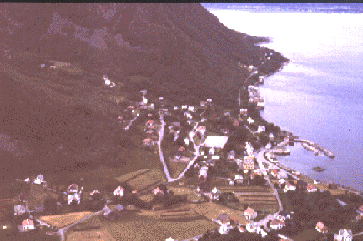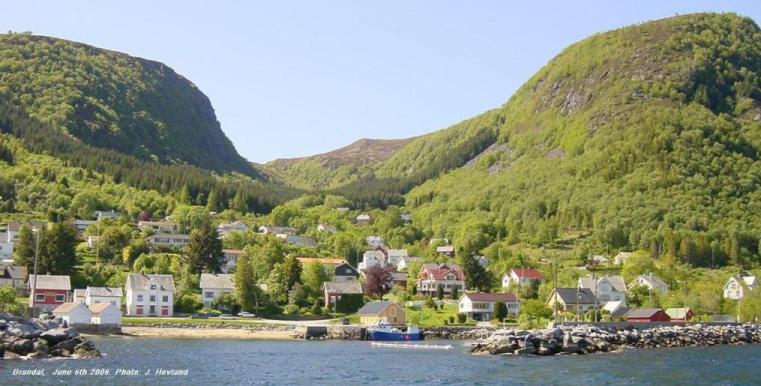



This photo shows the Brandal village from the south, during the summer of 1984. Far to the north you can see Kvitneset, i.e. "The White Cape". The cape can for sure be a lovely place for fishing and recreation on calm summer days and nights. If you celebrate midsummer there, you will notify that the sun dips under the horizon just for a short time. However, when high running seas hits the rocks during bad weather, especially with north-westerly winds, you must for sure keep a safe distance to the sea.
Here is one of my latest photos from Brandal:

Men from Brandal started sealing in the Arctic back in the year 1898. In the beginning, these men, often called brandalingar, used rather small wooden sailing vessels for this highly adventurous service. Those early vessels, only 55-60 feet long, were normally rigged as cutters, ketches or sloops.
Semi-diesel engines were for the first time installed in some of the smaller crafts in the middle of the first decade of 1900 and in 1908 steam engines were installed in two of the cutter-rigged vessels, "Minna" and "Union".
Around 1910, new and larger sealing vessels were built. They were some 80-90 feet long, especially designed and
engineered for this though service, and normally equipped with steam engines. However, for many years to
come, sails were used for complemantary power, both in order to save fuel and to reduce heavy rolling when sailing across open seas.
The "Gunhild" was the last of the old sailing sealers from Brandal. She made her final visit to the Arctic in 1914. As a result of the development of new generations of reliable combustion engines, sealing vessels changed over to semi-diesel and diesel engines starting in the early 1920s. But skilled craftsmen still made the vessels of wood.
The first steel vessel designed especially for sealing
purposes and built by a Norwegian shipbuilder was launched in 1950. It was the new "M/S "Polaris"of Brandal, delivered by the A.M. Liaaen Shipyard in Aalesund to the company A/S Selfangeren Polaris. (In order to avoid misunderstanding, I mention here that there was another steel sealer delivered to a Norwegian firm two years earlier, but that was a vessel rather
conventionally designed and delivered from a Scottish shipyard.)
One of several inventions on the "Polaris" of 1950 worth mentioning was the closed and heated crow´s nest,
which you can see on top of her foremast. When navigating through ice, the skipper or his mate could control
both rudder and engine from this "flying bridge".
As long as wooden sealers were used, there were frequent loss of men and vessels. In some years, especially 1917, 1939 and 1952 Norway sustained high losses. In April 1917, in a very severe gale from northeast with temperatures down to minus 40 degrees centigrade, seven Norwegian sealers and 84 men disappeared almost whithout trace in the region between Spitzbergen, Jan Mayen and Northeast Greenland.
In February 1939, three wooden sealers from northern Norway were lost in the Atlantic, west of Iceland, during a hurricane. One of these vessels was lost with all 18 men. The crews from the other two were saved, one by the Swedish passenger ship "Drottningholm" and the other by two sealers from Brandal: "Polarbjörn" and "Polaris". The disaster in 1939 was somewhat special since radio communication between the different ships, including the the coastal radio station in Aalesund, this time made it possible to coordinate the rescue action.
The last tragedy of the three mentioned here, took place in April 1952. It was somewhat similar to the one in 1917. This time, a hurricane sunk five Norwegian wooden sealers, with loss of 78 men, in the same region north of Jan Mayen as in the tradgedy of 1917. This time, again, without leaving any trace. The bad weather came suddenly -- no radio communication was heard.
The Norwegian part of the home-page includes some pictures of Norwegian
wooden sealers representing different steps of development. Three of
these photos are included here.
At first the small wooden, cutterrigged "Minna", delivered in 1894.
Only 56,7 feet long she made her first trip to the Arctic in 1898. "Minna" was lost in the ice between Iceland and Greenland in July 1918. By that time she had been lengthend to 78,4 feet, in order to provide space for boiler and a 10 hp strong steam engine.
Then two pictures of the wooden sealer "Polaris" follows. At first a picture of the steamer as she was from the time of her maiden voyage in 1914 until 1937/38. The old lady was then modernized and lengthend from 106 to 118 ft. The last photo shows the modernized M/S "Polaris" in the ice, some 100 nautical miles east of Bell Isle in 1938.
The wooden "Polaris" was lost in the strait between Cape Chidley and Resolution Island in October 1942, when an explosion destroyed her. Two of the sailors were badly injured, but all men survived. After life saving help from some Eskimoes, the crew was transfered, first to the USCC "Bear" and later to the USCC "Tahoma".
Sealers no longer sail from Brandal in the tough and dangerous Arctic service. However, the community of Brandal, in rememberance of their brave sealing ancestors, has created a rather unique museum. The museum´s collections includes even the old wooden sealer "Aarvak". The old lady was set safely ashore in an excavated dry dock in 1998, just before Christmas. The preservation of old wooden vessels ashore costs however money, a great deal of mony. A shortage of foundation funding is therefore a major problem for the museum.
You may wonder why those early Norwegian fishermen risked their lives to hunt for seals. The explanation goes back over hundred years. Many of the first young men from Brandal who hunted seals were borne in the 1870s. Scandinavia had suffered at that time from several years of very poor harvest. Some of the coastal fisheries failed as well. The majority of the fishing boats were small and open and there were frequent losses of both men and boats.
However, starting in 1861, fishermen from the west coast of Sweden annual made voyages to the cod banks west of Sunnmöre, Norway. Many young Norwegians learned to handle the larger Swedish vessels. These men realized that they had to leave the old, small, open boats in favor of larger vessels in order to earn a decent living.
In due time these young men got vessels of their own and were no longer limited to coastal fishing. They learned the hard way that the financial side of running a vessel is far more complex than running a small, open boat. They simply had to expand the use of their vessels.
During fishing expeditions up north they learned in Tromsö that seal skins for fur fashion were in high demand in Europe and America. Blubber and oil were also in demand. In other words, sealing in combination with different seasonal fishing, may have been risky, but it was a realistic alternative to stabilize the economy of their families and their communities.
If you want to either comment upon this page or ask some questions, you are welcome. You can find my address here.
